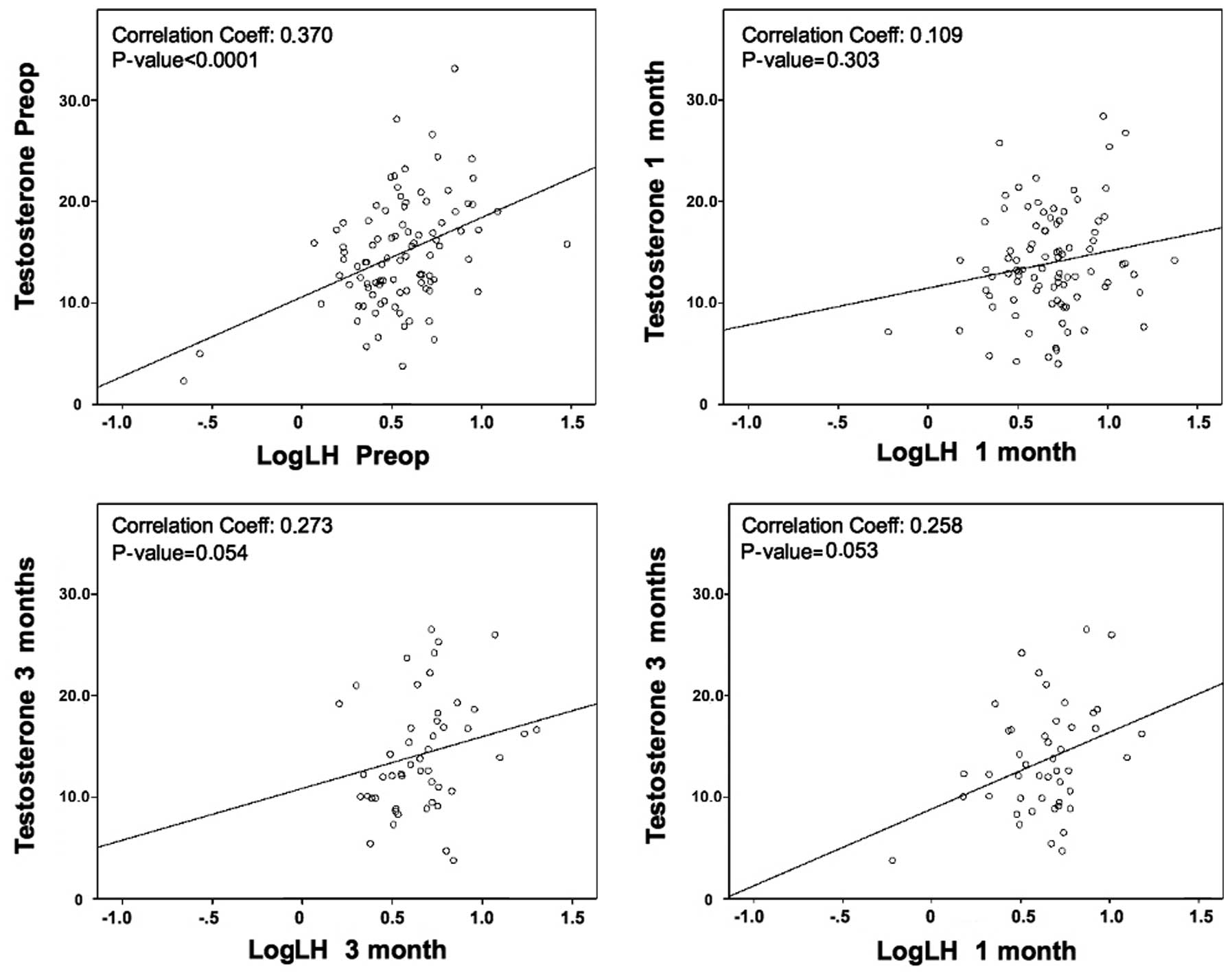|
1.
|
Gacci M, Eardley I, Giuliano F,
Hatzichristou D, Kaplan SA, Maggi M, McVary KT, Mirone V, Porst H
and Roehrborn CG: Critical analysis of the relationship between
sexual dysfunctions and lower urinary tract symptoms due to benign
prostatic hyperplasia. Eur Urol. 60:809–825. 2011. View Article : Google Scholar
|
|
2.
|
Lowe FC: Treatment of lower urinary tract
symptoms suggestive of benign prostatic hyperplasia: sexual
function. BJU Int. 95(Suppl 4): 12–18. 2005. View Article : Google Scholar
|
|
3.
|
Khera M: Androgens and erectile function:
a case for early androgen use in postprostatectomy hypogonadal men.
J Sex Med. 6(Suppl 3): 234–238. 2009. View Article : Google Scholar : PubMed/NCBI
|
|
4.
|
Gacci M, Corona G, Apolone G, Lanciotti M,
Tosi N, Giancane S, Masieri L, Serni S, Maggi M and Carini M:
Influence of serum testosterone on urinary continence and sexual
activity in patients undergoing radical prostatectomy for
clinically localized prostate cancer. Prostate Cancer Prostatic
Dis. 13:168–172. 2010. View Article : Google Scholar
|
|
5.
|
Gacci M, Ierardi A, Rose AD, Tazzioli S,
Scapaticci E, Filippi S, Maggi M, Nicita G, Carini M and Montorsi
F: Vardenafil can improve continence recovery after bilateral nerve
sparing prostatectomy: results of a randomized, double blind,
placebo-controlled pilot study. J Sex Med. 7:234–243. 2010.
View Article : Google Scholar
|
|
6.
|
Yamamoto S, Yonese J, Kawakami S, Ohkubo
Y, Tatokoro M, Komai Y, Takeshita H, Ishikawa Y and Fukui I:
Preoperative serum testosterone level as an independent predictor
of treatment failure following radical prostatectomy. Eur Urol.
52:696–701. 2007. View Article : Google Scholar
|
|
7.
|
Isom-Batz G, Bianco FJ Jr, Kattan MW,
Mulhall JP, Lilja H and Eastham JA: Testosterone as a predictor of
pathological stage in clinically localized prostate cancer. J Urol.
173:1935–1937. 2005. View Article : Google Scholar : PubMed/NCBI
|
|
8.
|
Lane BR, Stephenson AJ, Magi-Galluzzi C,
Lakin MM and Klein EA: Low testosterone and risk of biochemical
recurrence and poorly differentiated prostate cancer at radical
prostatectomy. Urology. 72:1240–1245. 2008. View Article : Google Scholar : PubMed/NCBI
|
|
9.
|
Miller LR, Partin AW, Chan DW, Bruzek DJ,
Dobs AS, Epstein JI and Walsh PC: Influence of radical
prostatectomy on serum hormone levels. J Urol. 160:449–453. 1998.
View Article : Google Scholar : PubMed/NCBI
|
|
10.
|
Olsson M, Ekström L, Schulze J, Kjellman
A, Akre O, Rane A and Gustafsson O: Radical prostatectomy:
influence on serum and urinary androgen levels. Prostate.
70:200–205. 2010.PubMed/NCBI
|
|
11.
|
Lackner JE, Maerk I, Koller A, Bieglmayer
C, Marberger M, Kratzik C and Schatzl G: Serum inhibin - not a
cause of low testosterone levels in hypogonadal prostate cancer?
Urology. 72:1121–1124. 2008. View Article : Google Scholar : PubMed/NCBI
|
|
12.
|
Madersbacher S, Schatzl G, Bieglmayer C,
Reiter WJ, Gassner C, Berger P, Zidek T and Marberger M: Impact of
radical prostatectomy and TURP on the
hypothalamic-pituitary-gonadal hormone axis. Urology. 60:869–874.
2002. View Article : Google Scholar : PubMed/NCBI
|
|
13.
|
Heidenreich A, Aus G, Bolla M, Joniau S,
Matveev VB, Schmid HP and Zattoni F: European Association of
Urology: EAU guidelines on prostate cancer. Eur Urol. 53:68–80.
2008. View Article : Google Scholar : PubMed/NCBI
|
|
14.
|
Carini M, Masieri L, Minervini A, Lapini A
and Serni S: Oncological and functional results of antegrade
radical retropubic prostatectomy for the treatment of clinically
localised prostate cancer. Eur Urol. 53:554–561. 2008. View Article : Google Scholar
|
|
15.
|
Corona G, Boddi V, Lotti F, Gacci M,
Carini M, De Vita G, Sforza A, Forti G, Mannucci E and Maggi M: The
relationship of testosterone to prostate-specific antigen in men
with sexual dysfunction. J Sex Med. 7:284–292. 2010. View Article : Google Scholar : PubMed/NCBI
|
|
16.
|
Sasagawa I, Nakada T, Suzuki H, Adachi Y
and Adachi M: Effect of transurethral resection of prostate on
plasma hormone levels in benign prostatic hyperplasia. Br J Urol.
72:611–614. 1993. View Article : Google Scholar : PubMed/NCBI
|
|
17.
|
Türkölmez K, Bozlu M, Sarica K, Gemalmaz
H, Ozdiler E and Gögüş O: Effects of transurethral prostate
resection and transurethral laser prostatectomy on plasma hormone
levels. Urol Int. 61:162–167. 1998.PubMed/NCBI
|
|
18.
|
Reyes JG, Farias JG, Henríquez-Olavarrieta
S, Madrid E, Parraga M, Zepeda AB and Moreno RD: The hypoxic
testicle: physiology and pathophysiology. Oxid Med Cell Longev.
2012:9292852012. View Article : Google Scholar : PubMed/NCBI
|
|
19.
|
Vignozzi L, Filippi S, Morelli A, Marini
M, Chavalmane A, Fibbi B, Silvestrini E, Mancina R, Carini M,
Vannelli GB, Forti G and Maggi M: Cavernous neurotomy in the rat is
associated with the onset of an overt condition of hypogonadism. J
Sex Med. 6:1270–1283. 2009. View Article : Google Scholar : PubMed/NCBI
|
|
20.
|
Daniell HW, Clark JC, Pereira SE, Niazi
ZA, Ferguson DW, Dunn SR, Figueroa ML and Stratte PT: Hypogonadism
following prostate-bed radiation therapy for prostate carcinoma.
Cancer. 91:1889–1895. 2001. View Article : Google Scholar : PubMed/NCBI
|
|
21.
|
Gacci M, Simonato A, Masieri L, Gore JL,
Lanciotti M, Mantella A, Rossetti MA, Serni S, Varca V, Romagnoli
A, Ambruosi C, Venzano F, Esposito M, Montanaro T, Carmignani G and
Carini M: Urinary and sexual outcomes in long-term (5+ years)
prostate cancer disease free survivors after radical prostatectomy.
Health Qual Life Outcomes. 7:942009.
|
















